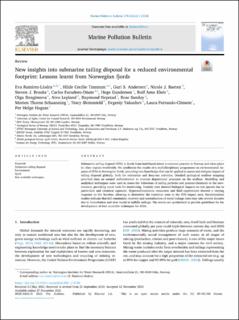| dc.contributor.author | Ramirez-Llodra, Eva | |
| dc.contributor.author | Trannum, Hilde Cecilie | |
| dc.contributor.author | Andersen, Guri Sogn | |
| dc.contributor.author | Baeten, Nicole | |
| dc.contributor.author | Brooks, Steven | |
| dc.contributor.author | Escudero-Oñate, Carlos | |
| dc.contributor.author | Gundersen, Hege | |
| dc.contributor.author | Kleiv, Rolf Arne | |
| dc.contributor.author | Ibragimova, Olga | |
| dc.contributor.author | Lepland, Aivo | |
| dc.contributor.author | Nepstad, Raymond | |
| dc.contributor.author | Sandøy, Roar | |
| dc.contributor.author | Schaanning, Morten | |
| dc.contributor.author | Shimmield, Tracy | |
| dc.contributor.author | Yakushev, Evgeniy | |
| dc.contributor.author | Ferrando-Climent, Laura | |
| dc.contributor.author | Høgaas, Per Helge | |
| dc.date.accessioned | 2021-12-10T09:14:17Z | |
| dc.date.available | 2021-12-10T09:14:17Z | |
| dc.date.created | 2021-11-29T14:52:02Z | |
| dc.date.issued | 2022 | |
| dc.identifier.issn | 0025-326X | |
| dc.identifier.uri | https://hdl.handle.net/11250/2833717 | |
| dc.description.abstract | Submarine tailing disposal (STD) in fjords from land-based mines is common practice in Norway and takes place in other regions worldwide. We synthesize the results of a multidisciplinary programme on environmental impacts of STDs in Norwegian fjords, providing new knowledge that can be applied to assess and mitigate impact of tailing disposal globally, both for submarine and deep-sea activities. Detailed geological seafloor mapping provided data on natural sedimentation to monitor depositional processes on the seafloor. Modelling and analytical techniques were used to assess the behaviour of tailing particles and process-chemicals in the environment, providing novel tools for monitoring. Toxicity tests showed biological impacts on test species due to particulate and chemical exposure. Hypersedimentation mesocosm and field experiments showed a varying response on the benthos, allowing to determine the transition zone in the STD impact area. Recolonisation studies indicate that full community recovery and normalisation of metal leakage rates may take several decades due to bioturbation and slow burial of sulfidic tailings. The results are synthesised to provide guidelines for the development of best available techniques for STDs. | en_US |
| dc.language.iso | eng | en_US |
| dc.rights | Attribution-NonCommercial-NoDerivatives 4.0 Internasjonal | * |
| dc.rights.uri | http://creativecommons.org/licenses/by-nc-nd/4.0/deed.no | * |
| dc.title | New insights into submarine tailing disposal for a reduced environmental footprint: Lessons learnt from Norwegian fjords | en_US |
| dc.type | Peer reviewed | en_US |
| dc.type | Journal article | en_US |
| dc.description.version | publishedVersion | en_US |
| dc.rights.holder | © 2021 The Authors. | en_US |
| dc.source.volume | 174 | en_US |
| dc.source.journal | Marine Pollution Bulletin | en_US |
| dc.identifier.doi | 10.1016/j.marpolbul.2021.113150 | |
| dc.identifier.cristin | 1960983 | |
| dc.relation.project | Norges forskningsråd: 272749 | en_US |
| dc.relation.project | Norges forskningsråd: 236658 | en_US |
| cristin.ispublished | true | |
| cristin.fulltext | original | |
| cristin.qualitycode | 1 | |

